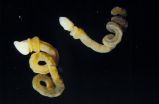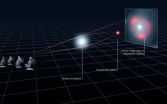(Press-News.org) This press release is available in French.
Christopher Cameron of the University of Montreal's Department of Biological Sciences and his colleagues have unearthed a major scientific discovery - a strange phallus-shaped creature they found in Canada's Burgess Shale fossil beds, located in Yoho National Park. The fossils were found in an area of shale beds that are 505 million years old.
Their study, to be published online in the journal Nature on March 13, 2013, confirms Spartobranchus tenuis is a member of the acorn worms group which are seldom-seen animals that thrive today in the fine sands and mud of shallow and deeper waters. Acorn worms are themselves part of the hemichordates, a group of marine animals closely related to today's sea stars and sea urchins. "Unlike animals with hard parts including teeth, scales and bones, these worms were soft-bodied, so their fossil record is extremely rare," said author Dr. Chris Cameron of the University of Montreal. "Our description of Spartobranchus tenuis, a creature previously unknown to science, pushes the fossil record of the enteropneusts back 200 million years to the Cambrian period, fundamentally changing our understanding of biodiversity from this period."
Since their discovery in the 19th-century, some of the biggest questions in hemichordate evolution have focused on the group's origins and the relationship between its two main branches: the enteropneusts and the pterobranchs, including graptolites. "One of the big punchlines from my graduate work, was molecular evidence that enteropneusts and pterobranchs are closely related" said Cameron, a specialist on the taxonomy, evolution and biogeography of hemichordates.
"It's astonishing how similar Spartobranchus tenuis fossils are to modern day acorn worms, except that they also formed fibrous tubes." The tubes provide a key missing link that connects the two main hemichordate groups. "The explosive radiation of graptolites in the Paleozoic planktonic ecosystems is known only from the diversity of their tubes. Our findings suggest that the tubes were lost in the lineage leading to modern day enteropneusts, but elaborated on in graptolites and retained to the present day in pterobranchs" added Cameron.
Hemichordates also share many of the same characteristics as chordates – a group of animals that includes humans – with the name hemichordate roughly translating to 'half a chordate.'
"Work from my lab has shown that enteropneusts filter feed using a pharynx perforated with gill slits, just like the invertebrate chordates" added Cameron. Spartobranchus tenuis probably fed on small particles of matter filtered from the seawater. "There are thousands of specimens at the Walcott Quarry in Yoho National Park, so it's possible Spartobranchus tenuis may have played an important role in moving carbon from the water column to the sediment in the early Burgess Shale environment" said Cameron.
Detailed analysis suggests Spartobranchus tenuis had a flexible body consisting of a short proboscis, collar and narrow elongate trunk terminating in a bulbous structure, which may have served as an anchor. The largest complete specimens examined were 10 centimetres long with the proboscis accounting for about half a centimetre. A large proportion of these worms was preserved in tubes, of which some were branched, suggesting the tubes were used as a dwelling structure.
Other members of the Spartobranchus tenuis research team are lead author Jean-Bernard Caron of the Royal Ontario Museum and Simon Conway Morris of the University of Cambridge.
INFORMATION:
About the Burgess Shale
The Burgess Shale is found in Yoho National Park, part of the Canadian Rocky Mountain Parks World Heritage Site, and is one of the most important fossil deposits for understanding the origin and early evolution of animals that took place during the Cambrian Explosion starting about 542 million years ago. To learn more about the Burgess Shale visit: http://www.burgess-shale.rom.on.ca.
Strange phallus-shaped creature provides crucial missing link
Discovery pushes fossil record back 200 million years
2013-03-14
ELSE PRESS RELEASES FROM THIS DATE:
Burgess Shale worm provides crucial missing link
2013-03-14
Canada's 505 million year-old Burgess Shale fossil beds, located in Yoho National Park, have yielded yet another major scientific discovery – this time with the unearthing of a strange phallus-shaped creature.
A study to be published online in the journal Nature on March 13 confirms Spartobranchus tenuis is a member of the acorn worms group which are seldom-seen animals that thrive today in the fine sands and mud of shallow and deeper waters. Acorn worms are themselves part of the hemichordates, a group of marine animals closely related to today's sea stars and sea ...
NIST mechanical micro-drum used as quantum memory
2013-03-14
BOULDER, Colo.— One of the oldest forms of computer memory is back again—but in a 21st century microscopic device designed by physicists at the National Institute of Standards and Technology (NIST) for possible use in a
quantum computer.
The NIST team has demonstrated that
information encoded as a specific point in a
traveling microwave signal—the vertical and horizontal positions of a wave pattern at a certain time—can be transferred to the mechanical beat of a micro-drum and later retrieved with 65 percent efficiency, a good figure for experimental systems like this. ...
ALMA rewrites history of Universe's stellar baby boom
2013-03-14
Observations with the Atacama Large Millimeter/submillimeter Array (ALMA) show that the most vigorous bursts of star birth in the cosmos took place much earlier than previously thought. The results are published in a set of papers to appear in the journal Nature and in the Astrophysical Journal. The research is the most recent example of the discoveries coming from the new international ALMA observatory, which celebrates its inauguration today.
The most intense bursts of star birth are thought to have occurred in the early Universe, in massive, bright galaxies. These ...
New MRI method fingerprints tissues and diseases
2013-03-14
A new method of magnetic resonance imaging (MRI) could routinely spot specific cancers, multiple sclerosis, heart disease and other maladies early, when they're most treatable, researchers at Case Western Reserve University and University Hospitals (UH) Case Medical Center suggest in the journal Nature.
Each body tissue and disease has a unique fingerprint that can be used to quickly diagnose problems, the scientists say.
By using new MRI technologies to scan for different physical properties simultaneously, the team differentiated white matter from gray matter from ...
Joslin scientists discover mechanism that regulates production of energy-burning brown fat
2013-03-14
BOSTON – March 13, 2013 – Joslin scientists have discovered a mechanism that regulates the production of brown fat, a type of fat which plays an important role in heat production and energy metabolism. The findings, which appear in the upcoming issue of Nature, may lead to new therapies that increase BAT formation to treat obesity.
Two types of fat tissue are present in humans and other mammals: white adipose tissue (WAT) or white fat, which stores fat; and brown adipose tissue (BAT) or brown fat, which burns fat to produce heat. Brown fat also metabolizes glucose and ...
Tobacco industry appears to have evaded FDA ban on 'light' cigarette descriptors
2013-03-14
Boston, MA – New research from Harvard School of Public Health (HPSH) shows that one year after the federal government passed a law banning word descriptors such as "light," "mild," and "low" on cigarette packages, smokers can still easily identify their brands because of color-coding that tobacco companies added to "light" packs after the ban. These findings suggest that the companies have, in effect, been able to evade the ban on misleading wording—thus still conveying the false and deceptive message that lights are safer than "regular" cigarettes.
In addition, the ...
Ancient, highly active galaxies discovered
2013-03-14
Pasadena, CA — Using information gathered from several telescopes, a team of astronomers, including Carnegie's Eric Murphy, searched the sky for very rarely seen dusty starburst galaxies, formed soon after the Big Bang. These galaxies are characterized by an unusually high rate of star formation. They are much more abundant in the early Universe than previously thought. Two of those identified are among the oldest ever found, indicating that these dusty starbursts likely evolve into the most massive galaxies ever observed in the local Universe. The results are published ...
ALMA finds 'monster' starburst galaxies in the early universe
2013-03-14
Astronomers using the Atacama Large Millimeter/submillimeter Array (ALMA) telescope have discovered starburst galaxies earlier in the Universe's history than they were previously thought to have existed. These newly discovered galaxies represent what today's most massive galaxies looked like in their energetic, star-forming youth. The research is the most recent example of the discoveries coming from the new international ALMA observatory, which celebrates its inauguration today.
The results, published in a set of papers to appear in the journal Nature and in the Astrophysical ...
Lower incidence of genital warts in young girls
2013-03-14
The incidence of genital warts, or condylomata, declined by 93 per cent in girls given the HPV vaccine before the age of 14, according to a Swedish national registry study. The study was carried out by researchers at Karolinska Institutet in Sweden, and published in Journal of the National Cancer Institute.
Using a selection of population-based registries, the researchers at Karolinska Institutet studied 124,000 girls and women in Sweden between 10 and 44 years old who had received the HPV vaccine against condyloma and cervical cancer at some time between 2006 and 2010. ...
Shock treatment can kill -- Clinical trial shows how 'standard' procedure results in children's deaths
2013-03-14
Results from the Fluid Expansion as Supportive Therapy (FEAST) trial in East Africa show that children who are given fluid to treat shock have an increased risk of death due to cardiovascular collapse at 48 hours. These findings in BioMed Central's open access journal BMC Medicine challenge the generally held idea that early and rapid reversal of shock by fluid resuscitation translates into longer-term survival benefits.
The FEAST trial was conducted in six African hospitals across Kenya, Tanzania and Uganda without intensive care facilities. It included 3000 children ...
LAST 30 PRESS RELEASES:
Injectable breast ‘implant’ offers alternative to traditional surgeries
Neuroscientists devise formulas to measure multilingualism
New prostate cancer trial seeks to reduce toxicity without sacrificing efficacy
Geometry shapes life
A CRISPR screen reveals many previously unrecognized genes required for brain development and a new neurodevelopmental disorder
Hot flush treatment has anti-breast cancer activity, study finds
Securing AI systems against growing cybersecurity threats
Longest observation of an active solar region
Why nail-biting, procrastination and other self-sabotaging behaviors are rooted in survival instincts
Regional variations in mechanical properties of porcine leptomeninges
Artificial empathy in therapy and healthcare: advancements in interpersonal interaction technologies
Why some brains switch gears more efficiently than others
UVA’s Jundong Li wins ICDM’S 2025 Tao Li Award for data mining, machine learning
UVA’s low-power, high-performance computer power player Mircea Stan earns National Academy of Inventors fellowship
Not playing by the rules: USU researcher explores filamentous algae dynamics in rivers
Do our body clocks influence our risk of dementia?
Anthropologists offer new evidence of bipedalism in long-debated fossil discovery
Safer receipt paper from wood
Dosage-sensitive genes suggest no whole-genome duplications in ancestral angiosperm
First ancient human herpesvirus genomes document their deep history with humans
Why Some Bacteria Survive Antibiotics and How to Stop Them - New study reveals that bacteria can survive antibiotic treatment through two fundamentally different “shutdown modes”
UCLA study links scar healing to dangerous placenta condition
CHANGE-seq-BE finds off-target changes in the genome from base editors
The Journal of Nuclear Medicine Ahead-of-Print Tip Sheet: January 2, 2026
Delayed or absent first dose of measles, mumps, and rubella vaccination
Trends in US preterm birth rates by household income and race and ethnicity
Study identifies potential biomarker linked to progression and brain inflammation in multiple sclerosis
Many mothers in Norway do not show up for postnatal check-ups
Researchers want to find out why quick clay is so unstable
Superradiant spins show teamwork at the quantum scale
[Press-News.org] Strange phallus-shaped creature provides crucial missing linkDiscovery pushes fossil record back 200 million years



